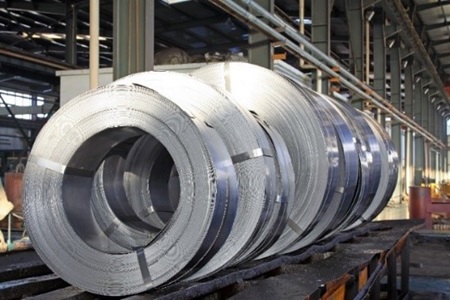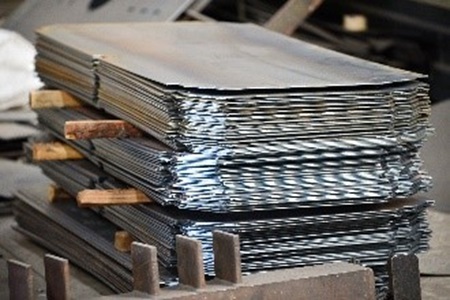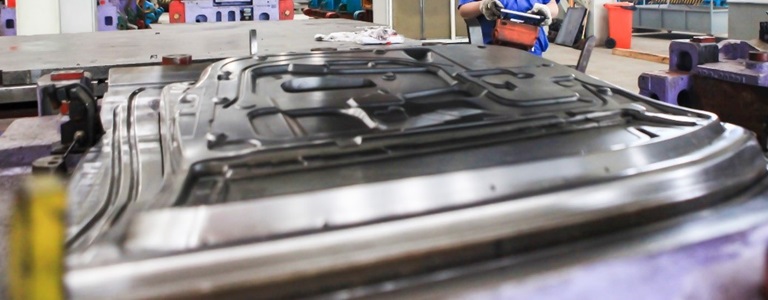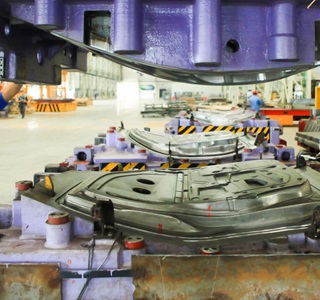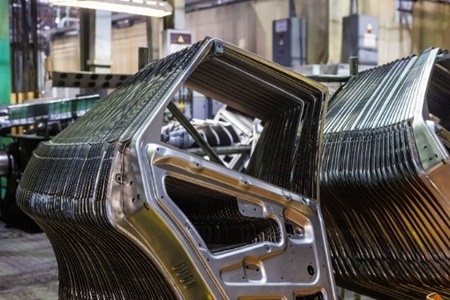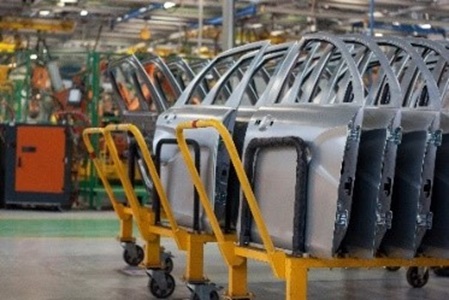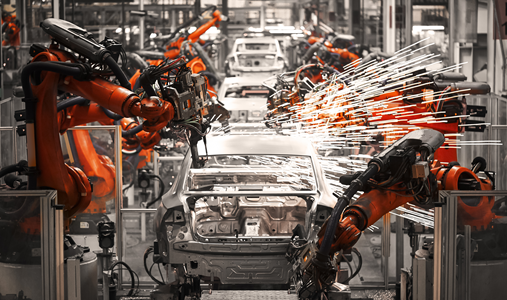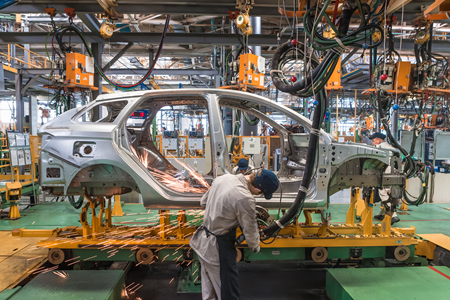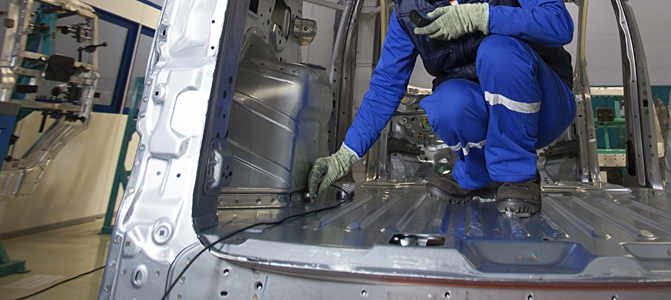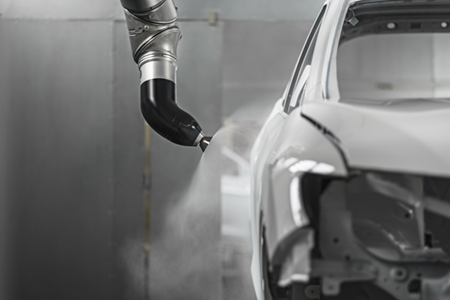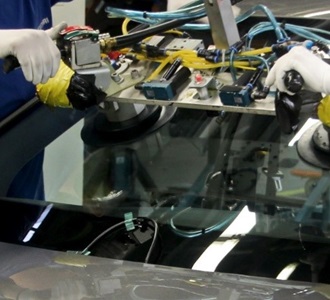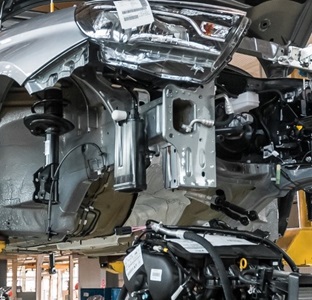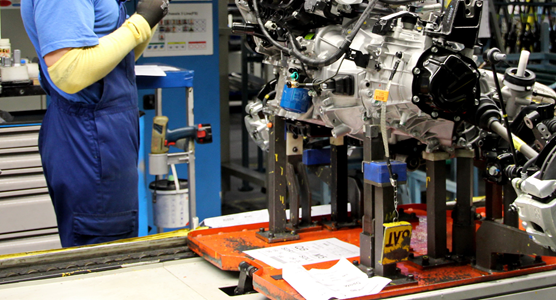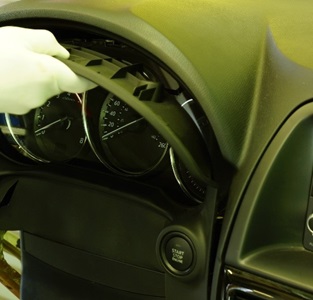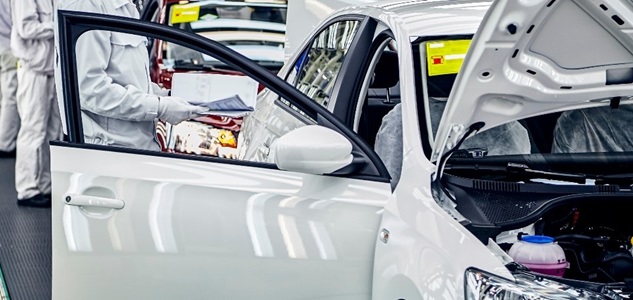Vehicle Manufacturing
"If you think you can do a thing or think you can’t do a thing, you’re right"
One thing mankind has gotten right over the years has been continuously innovating. The horseless carriage, an early name for the motor car, kicked off the automotive industry in the 1860s. Up to that point, only animals, typically horses, reserved the right to transport people around. Hence the term “horsepower”.

Horsepower
Most automotive buffs view the automotive industry’s true start as taking place in the late 1800s, when German inventor Karl Benz invented the "Motorwagen". Even with that breakthrough, automobiles did not take off in popularity immediately. In their early years, cars were mostly purchased by wealthy individuals, primarily because of cost.
Ford's Invention
European inventors may have developed the car, but it was Americans that embraced its production. In 1913, Henry Ford pioneered the assembly line for mass-producing vehicles, making them affordable for almost everyone.
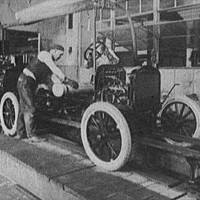
Work performed on Ford's assembly line
Ford’s production method was based on the idea of simply assembling interchangeable component parts across a conveyor belt-based assembly line. Prior to his invention, coaches and buggies were hand-built by skilled artisans, in small numbers, and at much higher costs. Ford's innovative design reduced the number of parts required, the skill required to perform the work, and the overall number of skilled fitters needed to get the job done. With decreased costs and increased output, Ford’s assembly line was destined to be one of America’s greatest innovations.
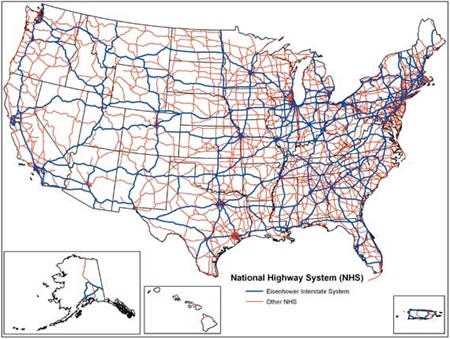
The U.S. Interstate Highway System helped fuel the auto industry’s growth, changed America’s landscape, and transformed rural areas into modern cities.
The core phase of today’s motor vehicle industry is still assembly, the process Ford pioneered over a hundred years ago. Today’s auto and truck manufacturing industry is expected to reach this year $99 billion in total revenue, with a total 2019 market value of $229.2 billion. The U.S. is the world’s second-largest automotive market for vehicle sales and production, and the impact of this industry is seen across the entire American economy.
95% of American households own a vehicle, and for good reason. The personal automobile lets people live, work, and play in ways that were inconceivable just a century ago. Automobiles stimulate tourism and allow increased access to outdoor recreation across all 50 states. Whether someone is taking a road trip across U.S. highways or commercial vehicles are delivering freight, the automotive industry has made its mark.
The automobile has essentially become a necessity for anyone living in the U.S.
Motor Vehicle Manufacturing Products and Sub-Industries
The industry’s core manufactured products are passenger automobiles; light-duty trucks such as pickups, vans, and SUVs; and heavy-duty trucks like buses. We break down each sub-industry within this industry: Automobile Manufacturing, Light Truck and Utility Manufacturing, and Heavy-Duty Truck Manufacturing.
Automobile Manufacturing
NAICS 336111
This sub-industry of motor vehicle manufacturing involves companies that manufacture complete automobiles. According to Hoovers, passenger cars make up 38.4% of the overall automotive market value. These motor vehicles drive on at least four wheels, are used for the transport of passengers, and contain no more than eight seats, in addition to the driver's seat.
Types of Passenger Cars:
- Convertible – the automobile may be driven with or without a roof in place
- Coupe – car with a sloping rear roofline, often sporty in nature, and with only two seats in the rear
- Hatchback – made with a rear door that swings upward
- EV - Electric Vehicles
- Hybrid Vehicles – cars that combine a combustion engine and battery
- Sedan – configured with three major compartments: cargo, passenger space, and engine
- Wagon – a sedan with a large cargo area, rear tailgate, and the space of an SUV

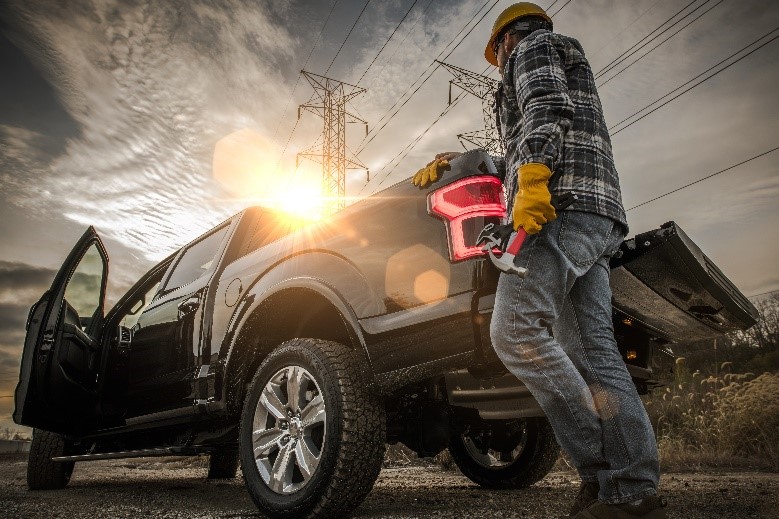
Light Truck and Utility Vehicle Manufacturing
NAICS 336112
Manufacturing companies in this sub-industry assemble light-duty vans, pick-up trucks, minivans, and SUVs. Light commercial vehicles (LCV) weigh up to 7 tons and are used for the carriage of goods. According to Hoovers, the truck market makes up roughly 59% of the entire U.S. economy.
Heavy-Duty Truck Manufacturing
NAICS 33612
Companies in this motor vehicle manufacturing sub-industry assemble and manufacture heavy-duty trucks, heavy-duty buses, and heavy-duty motor homes. These are vehicles that weigh greater than 7 tons.
- Buses and coaches - used for transporting passengers
- Heavy trucks - vehicles intended for the carriage of goods

Vehicle Production
Motor vehicle production is big business, with manufacturing occurring across the entire globe. To compete in today’s market, automotive manufacturers manage large supply chains that cross over into geographic regions outside the company’s home country. The good news, from a global standpoint, is that world production has been on the rise, as shown in the image below.
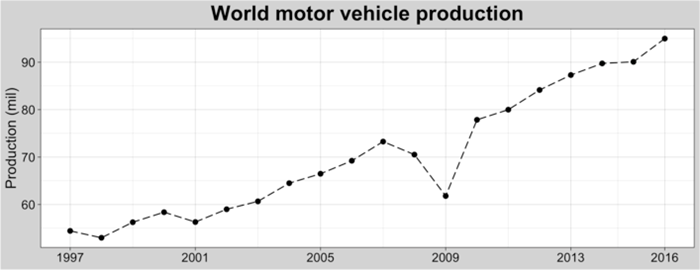
Worldwide vehicle production has been increasing at a rapid rate since the mid-’90s.
For the past 100+ years, the U.S. has played a vital role in worldwide motor vehicle production, starting with Ford’s assembly line innovation. However, towards the end of the 20th century, U.S. production of passenger cars gradually shifted to other countries. Consumer preferences began to change, with an increased demand for better performance, and the U.S. found itself falling behind foreign automotive companies for the first time.
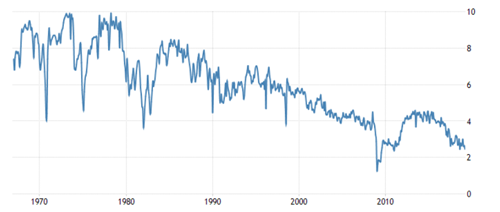
Click for larger view
American-made cars hit a record high production number in 1978. By 1980, Japan overtook the U.S.’s #1 position and became the world’s leading automobile producer. As you can see in the chart below, which utilizes data from the U.S. Bureau of Economic Analysis, U.S. auto production for passenger cars has continued to decline well into the 21st century.
Today, China is the largest producer of motor vehicles, including cars, trucks, coaches, and buses, as shown in the following image.
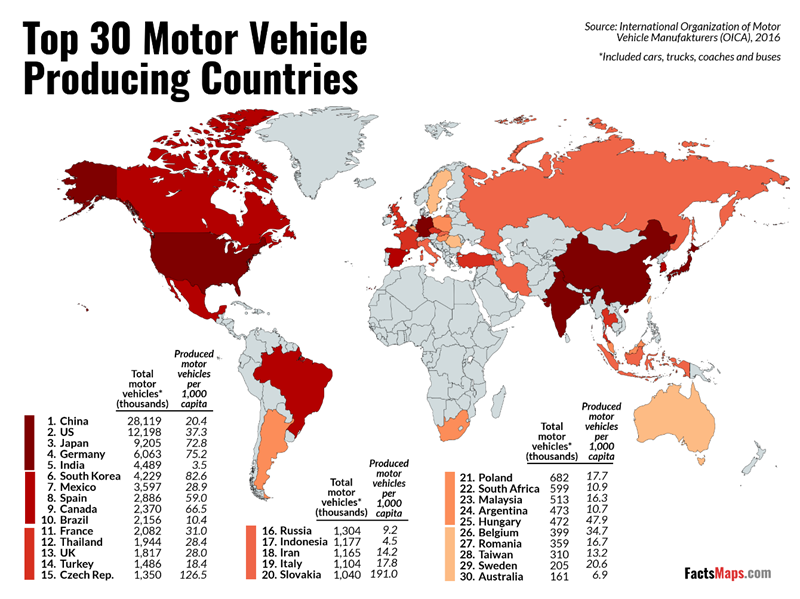
Click for larger view
With regard to U.S. production, it’s not all bad news for the automobile industry. Total production in America is directly behind China, due to the U.S. being the largest producer of commercial vehicles, with over 8,000,000 units produced per year.
Key Companies
In 1916, 55% of all cars in the world were Ford’s Model T. Over 100 years later, the Model T is no longer with us, but the Ford Motor Company still maintains a dominant market position in this industry. Today, Ford produces sixteen vehicles every 60 seconds.
The Big 3 automakers in the U.S. today are Ford, GM, and Chrysler. As we’ve mentioned, however, there are many automakers competing in the U.S. Here is a look at the top automotive companies operating in the U.S. and their employment numbers across the world.
| Company | Worldwide Employees |
|---|---|
| Volkswagen | 642,000 |
| Nissan | 450,000 |
| Toyota | 369124 |
| Fiat Chrysler | 235,915 |
| Honda North America Inc | 208,000 |
| Ford Motor Company | 199,000 |
| General Motors Company | 173,000 |
| Hyundai | 104,731 |
| Tesla, Inc. | 45,000 |
| Suzuki | 45,000 |
The American Auto Council highlights the following OEM share of production in the U.S.:
| Company | OEM share | # of Assembly Plants |
|---|---|---|
| Ford | 21% | 9 |
| General Motors | 18% | 12 |
| Fiat Chrysler Automobiles | 15% | 7 |
| Toyota | 11% | 4 |
| Honda | 11% | 5 |
| Nissan | 8% | 2 |
| Hyundai | 6% | 2 |
| Daimler | 3% | 2 |
| BMW | 3% | 1 |
| Volkswagen | 1% | 1 |
Plant Locations Across the U.S.
To produce vehicles, automakers need plants. Currently, three out of every five U.S. auto plants are owned by Chrysler, Ford, or General Motors. However, since the 1980s, when Japanese car makers began opening auto production plants in the U.S., the manufacturing arena has changed. New assembly plants, operated by foreign automakers, began appearing all across the southern states. Today, there are a vast number of foreign auto plants operating on U.S. soil, providing employment to thousands of Americans.
Here is a look at where some of the larger plants are located across the U.S. landscape.
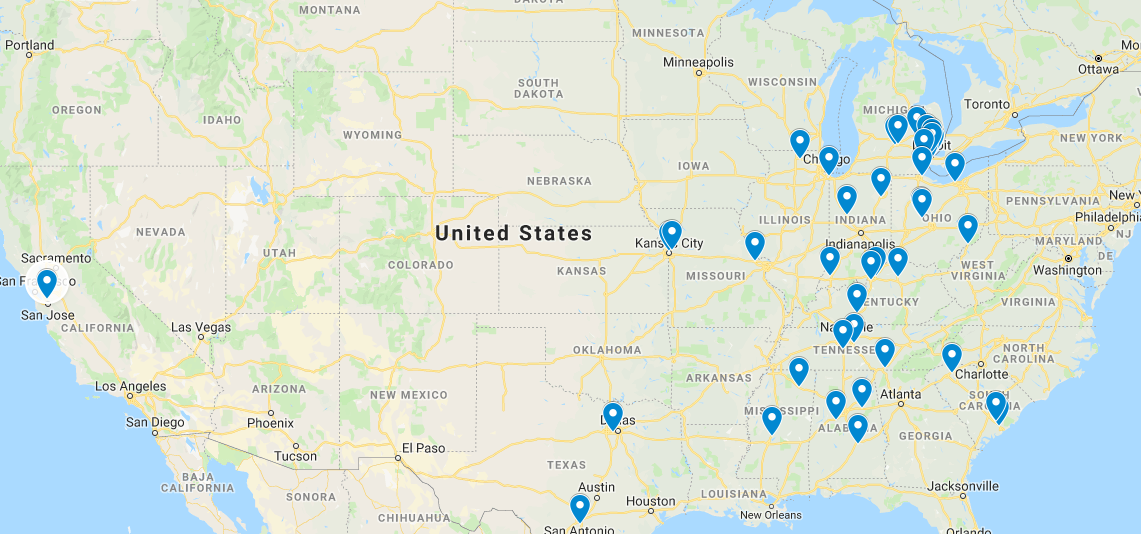
As you can see, automotive manufacturing plants are concentrated heavily in the Midwest and in the South. The map above shows where the following automotive plants are positioned in the U.S.:
| State | Zip | Company | Plant Name |
|---|---|---|---|
| Alabama | 35096 | Honda Manufacturing | Honda Manufacturing of Alabama, LLC |
| Alabama | 36105 | Hyundai Motor Company | Hyundai Motor Manufacturing Alabama |
| Alabama | 35490 | Mercedes | Mercedes-Benz U.S. International, Inc. |
| California | 94538 | Tesla | Tesla Factory |
| Illinois | 61008 | Fiat Chrysler | Belvidere Assembly Plant |
| Illinois | 60633 | Ford Motor Company | Chicago Assembly |
| Indiana | 47905 | Subaru Corporation | Subaru of Indiana Automotive, Inc. |
| Indiana | 47670 | Toyota Motor Corporation | Toyota Motor Manufacturing Indiana |
| Indiana | 46783 | General Motors | Fort Wayne Assembly |
| Kansas | 66115 | General Motors | Fairfax Assembly |
| Kentucky | 42101 | General Motors | Bowling Green Assembly |
| Kentucky | 40324 | Toyota Motor Corporation | Toyota Motor Manufacturing Kentucky |
| Kentucky | 40241 | Ford Motor Company | Kentucky Truck Plant |
| Kentucky | 40213 | Ford Motor Company | Louisville Assembly Plant |
| Michigan | 48120 | Ford Motor Company | Dearborn Truck |
| Michigan | 48211 | General Motors | Detroit/Hamtramck Assembly |
| Michigan | 48215 | Fiat Chrysler | Jefferson North Assembly |
| Michigan | 48214 | Fiat Chrysler | Mack Avenue Engine Complex |
| Michigan | 48134 | Ford Motor Company | Flat Rock Assembly Plant |
| Michigan | 48507 | General Motors | Flint Truck Assembly |
| Michigan | 48359 | General Motors | Orion Assembly |
| Michigan | 48917 | General Motors | Lansing Delta Township Assembly |
| Michigan | 48933 | General Motors | Lansing Grand River Assembly |
| Michigan | 48312 | Fiat Chrysler | Sterling Heights Assembly |
| Michigan | 48091 | Fiat Chrysler | Warren Truck Assembly |
| Michigan | 48184 | Ford Motor Company | Michigan Assembly Plant |
| Mississippi | 38828 | Toyota Motor Corporation | Toyota Motor Manufacturing Mississippi |
| Mississippi | 39046 | Nisan Motor Company | Nissan North America, Inc. Canton |
| Missouri | 64119 | Ford Motor Company | Kansas City Assembly |
| Missouri | 63385 | General Motors | Wentzville Assembly |
| Ohio | 44012 | Ford Motor Company | Ohio Assembly |
| Ohio | 43319 | Honda Manufacturing | Honda of America Manufacturing, Inc. |
| Ohio | 43040 | Honda Manufacturing | Honda of America Manufacturing, Inc. |
| Ohio | 43608 | Fiat Chrysler | Toledo Complex |
| South Carolina | 29456 | Mercedes | Mercedes-Benz Vans, LLC. |
| South Carolina | 29472 | Volvo Cars | Volvo Cars USA LLC |
| South Carolina | 29651 | BMW Group | BMW US Manufacturing Company, LLC |
| Tennessee | 37416 | Volkswagen Group | Volkswagen Chattanooga Assembly Plant |
| Tennessee | 37167 | Nisan Motor Company | Nissan North America, Inc. Smyrna |
| Tennessee | 37174 | General Motors | Spring Hill Manufacturing |
| Texas | 76010 | General Motors | Arlington Assembly |
| Texas | 78264 | Toyota Motor Corporation | Toyota Motor Manufacturing Texas |
| West Virgina | 26187 | Hino Motors | Hino Motors Manufacturing U.S.A., Inc. |
Here are the top producing American car plants from the list above.
Automotive Manufacturing Process
Even though technology has transformed motor vehicle manufacturing since the days of Ford’s initial assembly line, there are still many of the same principles at work. Assembly still combines standardization, interchangeability, and continuity. Automobiles flow to the individual worker at each specific workstation, with each worker performing a precise task.
The assembly line remains the place where things come together in one spot. There are several sub-assembly areas, like doors and engines, however, the assembly line is still where highly specialized employees make the vehicle come to life.
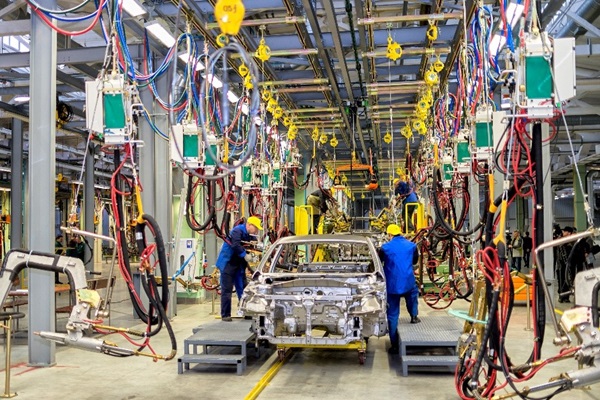
Vehicle Assembly
A modern automotive production line utilizes what is referred to as the division of labor. In this system, instead of each person performing an entire job from start to finish, everyone focuses on a small piece of the job, bringing the smaller parts together until the final vehicle is assembled. It is this innovative thinking that helped Ford mass produce those first Model Ts in 1908 and that approach remains the most cost-effective method of assembly today.
Building and assembling vehicles requires a complex assembly progression. Throughout the whole process, frequent inspections are performed to ensure the vehicle’s quality. We highlight the entire process and the hazards employees face change as the vehicle makes its way through the assembly process.
Assembly Process for Manufacturing Vehicles
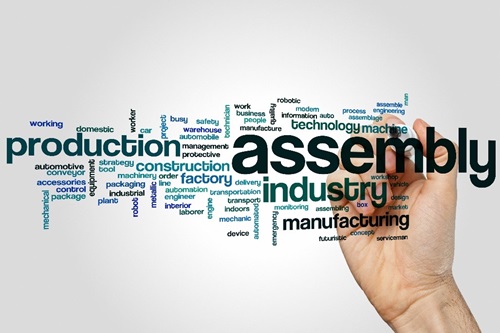
Keep in mind, each automaker utilizes its own unique manufacturing process. Some plants strictly assemble vehicles, relying heavily on just-in-time manufacturing, as castings/forgings, electrical equipment, and other parts are brought to the factory. Others manufacture their complete engines, plastic moldings, and other parts at the in-house automotive plant.
The flow chart below highlights automotive manufacturing as you move down the assembly line. Inspecting blanks, stamping metal parts and loading welding lines is where cut-resistant gloves and sleeves become a must. Keep in mind though, PPE changes across each step of the manufacturing process.
These are the core production stages found in auto plants, along with a full visual map showing the sequence of events.
Click the arrows or drag to advance steps
In the U.S., there are roughly 130,000 assemblers working in motor vehicle manufacturing plants.
Total Automotive Manufacturing Employment
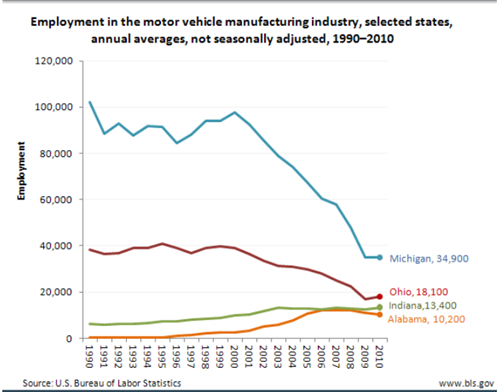
The Bureau of Labor Statistics (BLS) reports there are a little over 217,000 U.S. automotive manufacturing workers, a number that has been declining for years, even though worldwide production continues to rise.
Are there concerns that fewer people are employed in automotive manufacturing today and that those numbers continue to drop? Well, in Michigan, the answer is yes, with a decline of nearly 65,000 workers in Motor City compared to thirty years ago. Robotics, technology, computers, standardization, cost reduction, and globalization have all played a part in reducing the total labor force.
Employment by State
Every state is an auto state, as motor vehicle manufacturing represents the largest manufacturing industry in the U.S. There are automotive establishments spread out across the entire country. If you don’t want to take our word for it, just check out this interactive map, created by Auto Alliance.
While every state has come connection to automotive, the majority of all motor vehicle manufacturing, more than half, occurs in three states: Michigan, Ohio, and Indiana. Here are the overall top 10 states for auto manufacturing.
One state that has seen a rise in auto manufacturing in recent years is Alabama, as you can see in the previous graph. When foreign facilities began moving to the U.S., they opened many of their plants in the southern U.S right-to-work states, where unions are not able to effectively organize. Since 1990, Alabama’s employment has risen from 400 automotive manufacturing jobs to numbers approaching 40,000 today.
Overall U.S. Automotive Industry
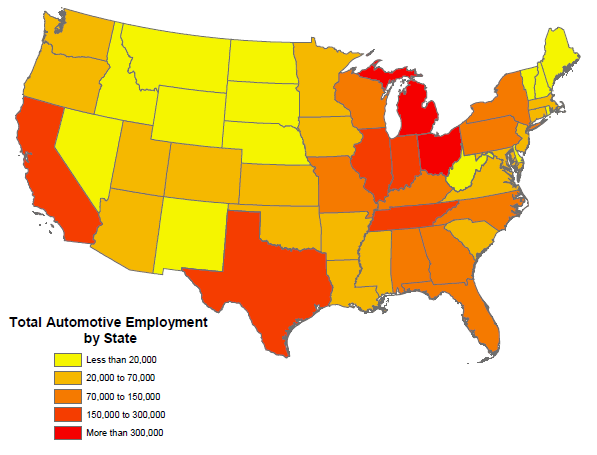
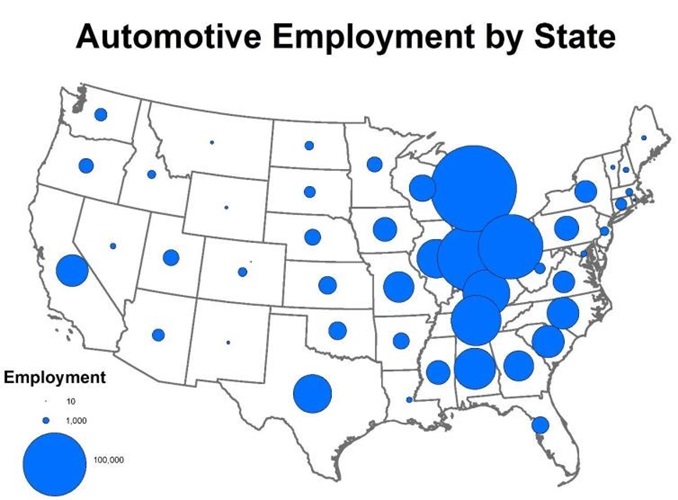
Northern U.S. Automotive Industry
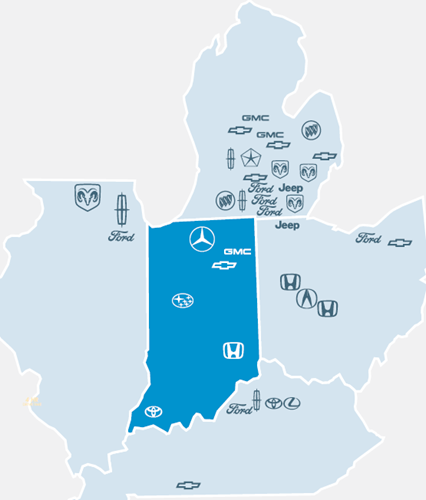
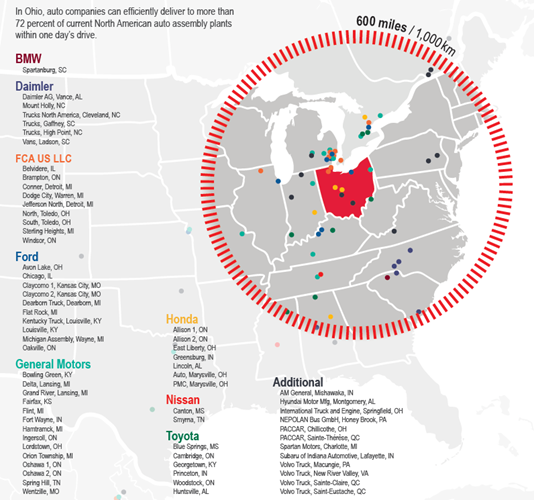
Central U.S. Automotive Industry
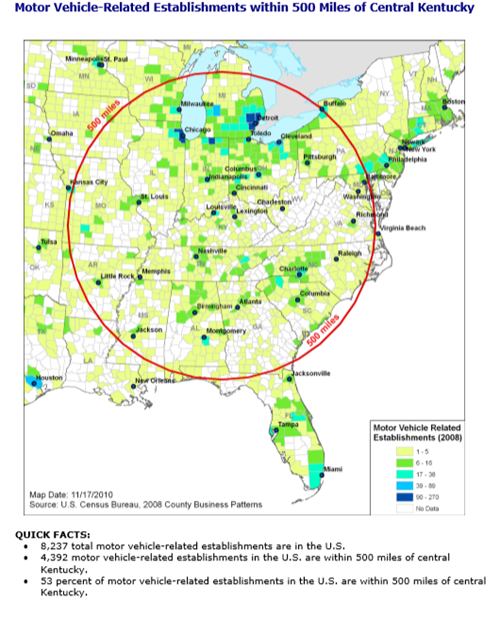
Southern U.S. Automotive Industry
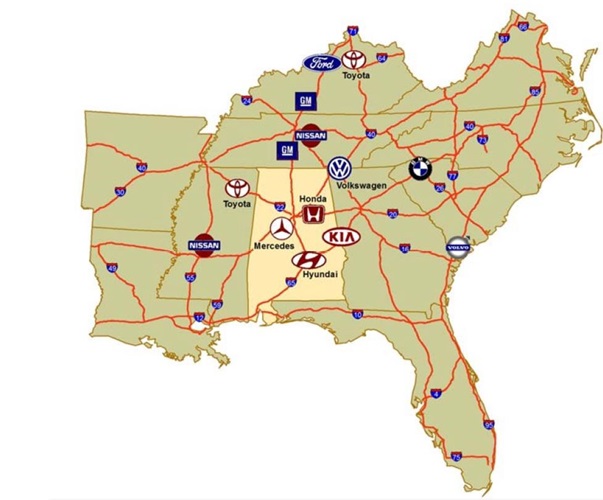
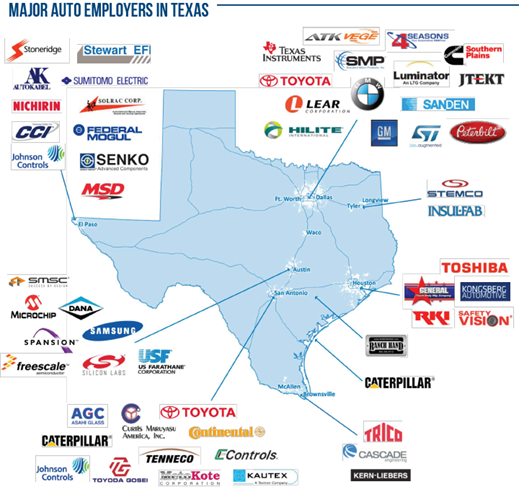
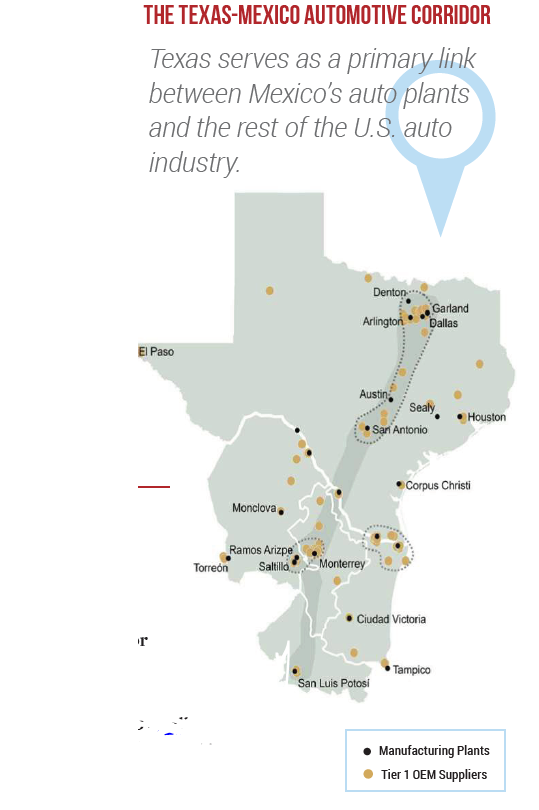
Here is a look at the occupations found in this industry.
Occupations
When it comes to employment, there is a multitude of jobs available to workers in the motor vehicle manufacturing industry. The top three occupations found in this industry are the following:
- Assemblers and Fabricators
- Maintenance Workers
- Construction Trades
Here is a look at the positions employing the most workers.
-
Assemblers and Fabricators
Assemble finished products and parts. There are around 130,000 of these workers in the Motor Vehicle Manufacturing. You will find this worker assembling bolts, using many different types of tools, and moving heavy parts. They construct finished products and the parts that go into them. These workers use many tools, machines, and most importantly need their hands protected. Common job titles for this occupation are Assembler and Fabricator.
-
Metal and plastic workers
Operate machines designed to cut, shape and form metal. There are roughly 14,000 employees found for this occupation. You will find these workers fabricating metal products, lifting heavy materials and working with their hands. Common job titles for this position are Sheet Metal Worker and Welder.
-
Industrial Machinery Installation, Repair, and Maintenance Workers
Lubricates machines, changes parts, and performs machinery maintenance. The Motor Vehicle Manufacturing industry employs a little over 10,000 of these workers. You will find these workers cleaning machine and machine parts. Cleaning solvents, oil and metalworking fluids are a definite concern for these workers. Common Job titles for this position are Lubricator, Maintenance Man, and Oiler.
-
Construction Trades Workers
Perform tasks involving physical labor. There are roughly 6,000 of these workers in Motor Vehicle Manufacturing. They operate hand and power tools of all types. You will find these workers preparing sites, digging trenches; erect scaffolding, applying paint to surfaces, sealants and assembling structures. Common job titles for this occupation are Helper, Laborer, Skill Laborer.
-
Material Moving Workers
Around 4,200 of these workers help move material and vehicles in the Motor Vehicle Manufacturing industry. That is a large number of hands needing to be protected. You will find these workers operating conveyors, transporting materials, and operating machines. Common job titles are Laborer and Operator.
-
Inspectors, Testers, Sorters, Samplers, and Weighers
Inspect machined, fabricated, or assembled parts. There are around 3,900 of these workers in motor vehicle manufacturing. You will find these workers inspecting equipment and structures. Common job titles for this position are Quality Technician, Inspector, and Picker / Pacer.
-
Laborers and material movers by hand
Workers that move materials, objects and stock. There are around 3,000 of these workers in the Motor Vehicle Manufacturing industry. Machine feeders also fall into this worker group. Common Job titles for this position are Line Tender, Laborer, and Materials Handler. Due to the use of one’s hands, wearing gloves is a must.
-
Industrial Machinery Mechanics
Repair, install, and adjust industrial machinery. There are around 2,900 of this occupation working in motor vehicle manufacturing. You will find these workers cutting and welding metal to repair broken metal parts. Job titles for this position are Fixer, Industrial Mechanic, and Master Mechanic.
-
Maintenance and Repair Workers
Keep machines, mechanical equipment, or the structure of an establishment in repair. There are around 1,300 of this occupation that works in Motor Vehicle Manufacturing. You will find these workers pipe fitting, repairing equipment, and repairing buildings. Job titles for this position are Maintenance Worker, Maintenance Mechanic, and Facilities Manager.
-
Tool and Die Makers
Lay out metal stock, operate machine tools, and assemble parts to make and repair dies. There are roughly 2,300 of these workers in the motor vehicle manufacturing industry. You will find these workers cutting and shaping metal, in addition to assembling machine fixtures. Common job titles for this position are Die Maker, Die Machinist, and Tool Repairer.
-
Painting Workers
You will find these workers applying paint coatings, cleaning production equipment, and positioning work pieces. There around roughly 2,300 of these works in the Motor Vehicle Manufacturing industry. They paint and coat surfaces. Workers are exposed to many contaminants. Common job titles for this occupation is Painter and Spray Painter.
-
Welding, Soldering and Brazing Machine Operators
Operate welding, soldering or brazing machines that weld, braze, or heat treat metal products. Roughly, 2,000 workers are found in the Motor Vehicle Manufacturing industry. You will find these workers adding material to workpieces, joining metal components, and annealing finished work pieces. Common Job titles for this position are Fabricator, Mig Welder, Spot Welder, Fitter-Welder, and Braze Operators.
-
Forming Machine Setters, Operators, and Tenders
Operate machines used to taper, shape, and form metal. Around 1,900 of these workers are found in motor vehicle manufacturing. You will find these workers removing dies, forging hammers, and moving metalwork pieces. Common job titles for this position are Forger, Blacksmith, Hammer Operator, and Forge Press Operators
-
Welding Cutters and Fitters
Use hand-welding, flame-cutting, hand soldering, and brazing equipment to weld/join metal components, fill holes, indentations, or seams of fabricated metal products. There are around 1,900 of these workers are employed in the Motor Vehicle Manufacturing industry. You will find these workers welding components in flat, vertical or overhead positions. Common Job titles for this position are Maintenance Welder, Mig Welder, and Welder/Fabricator.
Work Activities
An assembly line runs like a well-oiled machine. It does so because there are a lot of specialized workers who perform many tasks. Each worker must complete their assigned task within a certain takt time, ensuring production continues in an efficient manner.
Here are what workers in this industry do on a daily basis in an automotive plant.

Assembly
- Fastening components and parts
- Adjusting small parts and screws
- Assembling bolts
- Assembling chassis
- Assembling components like dashboards, panels, and seats
- Assembling finished products
- Attaching cables
- Body trimming
- Connecting devices
- Constructing finished products
- Feeling fine parts
- Moving heavy parts
- Assembling parts
- Using a wide range of tools
- Assembling electrical components and wire harnesses
Body Shop
- Assembling metal parts to form vehicle structures
Engine and Transmission Assembly
- Assembling oily objects and components
Injection Molding
- Deburring
- Handling molded parts
- Inspecting parts

Inspector and Testers
- Finishing
- Inspecting and touching vehicles for defects
- Inspecting for unnecessary burrs
- Inspecting machine-assembled parts
- Laboratory
Machine Tool Setter and CNC
- Inspecting metalwork pieces
- Forming metal with a machine-press
- Working with sharp metal
Machinist
- Assembling components
- Cutting, shaping, and forming metal
- Handling rough, jagged, and ultra-fine sharp parts
- Handling sharp small parts
- Metal handling
- Metalworking and manipulating metal parts
Maintenance and Repair
- Assembling and disassembling equipment
- Maintaining production machines
- Mounting equipment
- Repairing equipment and machinery
- Changing parts
- Cleaning machines
- Lubricating machines
- Maintaining machinery
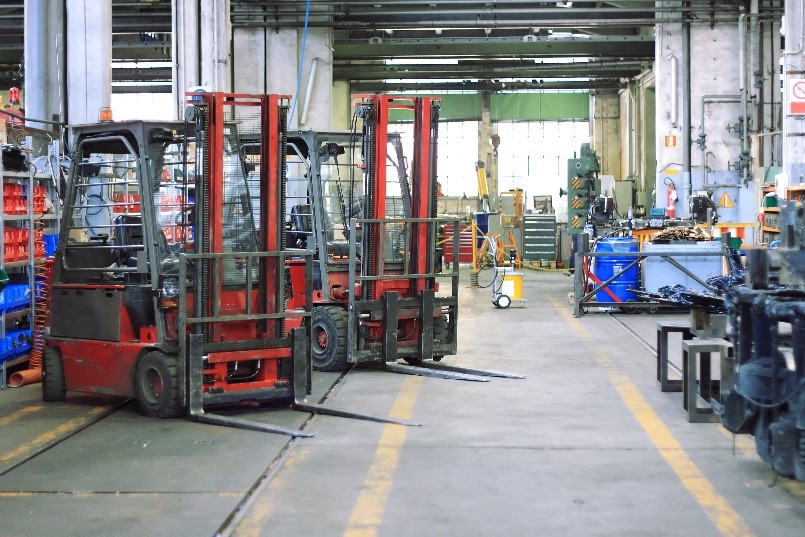
Material Moving
- Delivering finished vehicles
- Delivering parts to work stations
- Preparing components for assembly
Metal Stamping
- Bending and forming metal sheets to desired shapes
- Cutting and separating metal
- Handling metal panels
- Handling sharp metal parts formed from the presses
- Operating machine-press
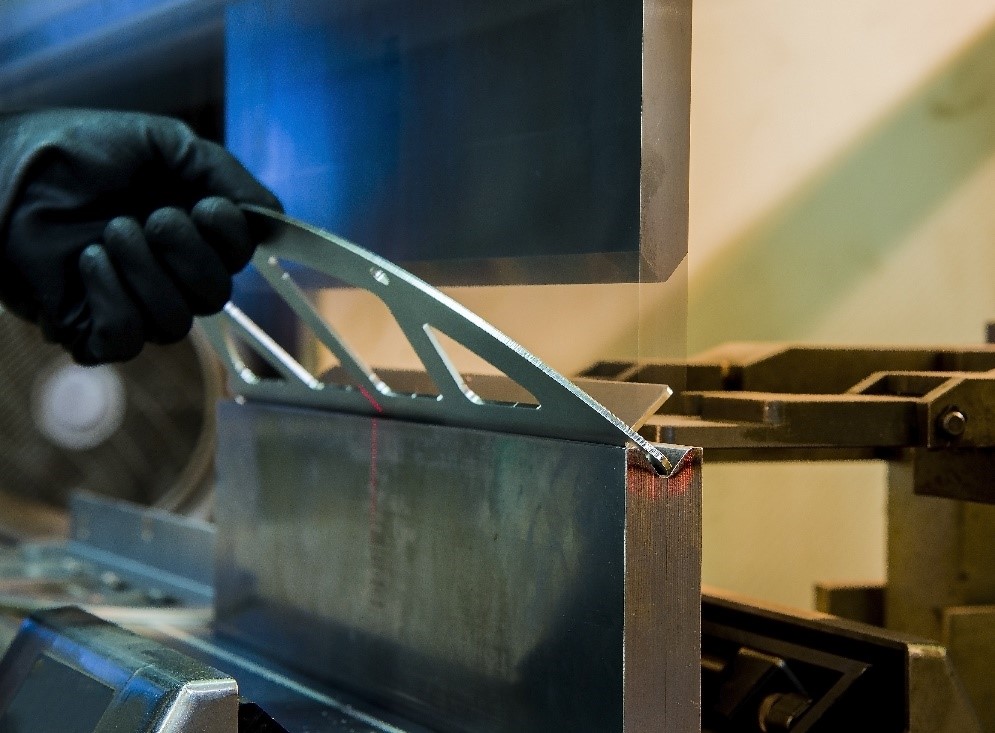
Paint Line
- Painting vehicle body
- Applying sealers
- Cleaning tools with solvents
- Cleaning vehicles
- Treating surfaces
- Touching up
- Working around chemicals
Many of the activities found in the automotive industry involve metal fabrication. Be sure to check out our Metal fabrication industry page for more information and resources.
Safety
When you examine the working conditions in early assembly lines from the 1920s, you may notice that cars were built in grime, greasy conditions, and dirty factories. Because of the difficult working conditions found across production plants, autoworkers looked for outside representation to help improve overall conditions.
The United Automobile Workers (UAW) union was recognized by GM and Chrysler in 1937, and then by Ford in 1941. Today’s workers would not recognize those early working conditions, with most of today’s work occurring on well-lit factory floors boasting extremely clean production lines.
Even with the improvements in automotive plants, we know safety and PPE are still important elements. Companies still pay close attention to and place a high priority on safety across manufacturing facilities. How do we know this? Just take a look at the BLS incident rates below for this industry and you’ll see.
In 2002, the number of work-related injury and illness cases averaged 12.1 per 100 full-time workers in motor vehicle manufacturing, compared with 7.2 in all other manufacturing industries and 5.3 in the entire private sector. The numbers clearly show these workers experience higher rates of injury when compared to most other industries.
According to the U.S. Bureau of Labor Statistics, today’s number of injuries are still double the number of injuries from all other industries. 6.44 out of every 100 motor vehicle manufacturing workers are injured, compared to 3.2 in all other industries.
| Sub Industry | NAICS # | # of Injuries for Every 100 Workers |
|---|---|---|
| Light truck and utility vehicle manufacturing | 336112 | 7.7 |
| Automobile and light-duty motor vehicle manufacturing | 33611 | 6.7 |
| Motor vehicle manufacturing | 3361 | 6.5 |
| Automobile manufacturing | 336111 | 6.2 |
| Heavy-duty truck manufacturing | 33612 | 5.1 |
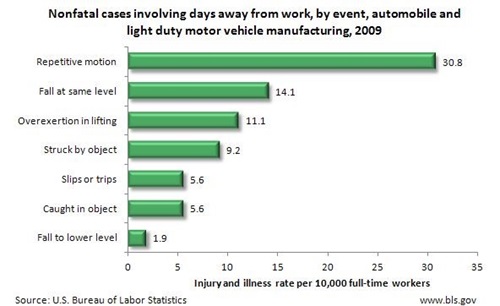
The above image highlights what kinds of injuries are likely to occur.
As shown in the above table, work performed in this industry comes with risks.
There is good news, though, when you look at this issue: injuries have been coming down in the 21st century. This decline is a testament to safety managers in the industry and advanced technologies improving worker protection.
No matter what safety measures are taken, workers will always be exposed to dangerous machinery and will always operate power tools that can easily bang up against their hands. Moreover, sharp metal is found everywhere on a vehicle’s body, creating a constant hazard to hands and arms. Since assembly is all about hands-on work, a worker’s hands can be injured rather quickly when assembling components, tightening bolts, and installing bumpers.
MCR Safety has some experience in motor vehicle manufacturing, since we’ve been in business for over 45 years. Check out all the PPE solutions we highlight below for motor vehicle manufacturing hazards. Let us keep you protected when manufacturing automobiles!
Common Vehicle Manufacturing Hazards
Find the right MCR Safety product that protects you against these common hazards.
Abrasive Handling
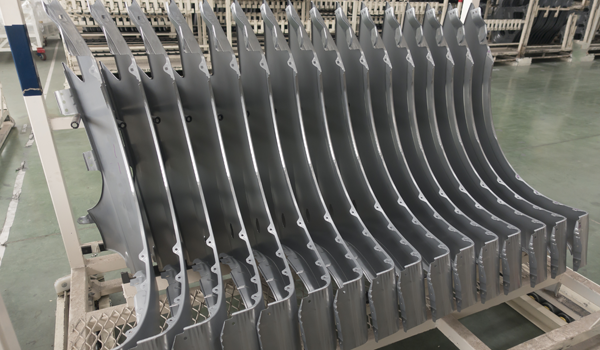
A glove’s coating takes a beating when working with stamped metal or the sand in die-casting. Higher abrasion-resistant gloves provide added protection.
Common Applications:
- Assembling metal parts to form vehicle structures
- Assembling and disassembling equipment
- Assembling parts
- Handling machined parts
Arm Injuries
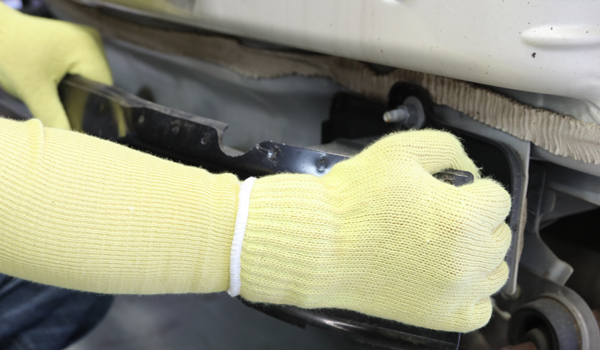
Metal is everywhere on a vehicle's body. Many injuries to auto workers occur when assembling, drilling bolts, and lifting parts over and over again. Cut protection up the arm is an absolute must. Check out our Kevlar® technology page for additional information.
Learn More About Arm Injuries ProtectionCommon Applications:
- Body Trimming
- Fastening components and parts
- Assembling components like dashboards, panels, and seats
- Using air tools around sharp metal
- Placing parts on frames
- Working around sharp edges
Chemicals and Liquids
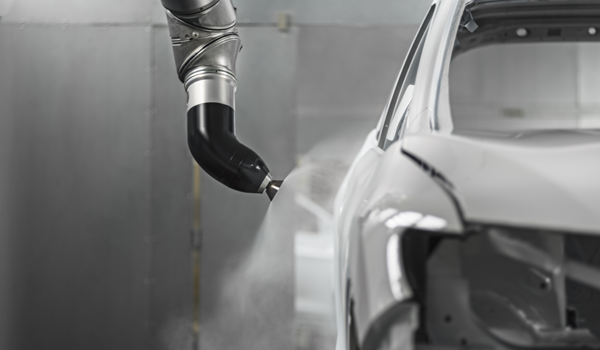
Even though most of the painting is automated, there are still some specialized workers who need protection from harsh chemicals and paints. Check out our Chemical Permeation Guide for specific chemical breakthrough times.
Learn More About Chemicals and Liquids ProtectionCommon Applications:
- Cleaning tools with solvents
- Cleaning vehicles
Crush
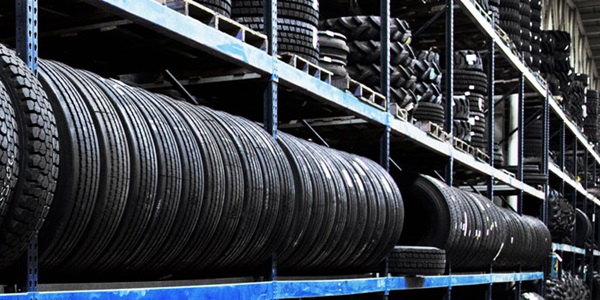
Back of hand protection is a necessity for those workers placing tires on frames. MCR Safety's Impact Protection Page highlights the multiple levels of protection we offer.
Learn More About Crush ProtectionCommon Applications:
- Assembling Parts
- Mounting and dismantling equipment
- Repairing equipment
- Maintaining machines
Cut and Sense of Touch
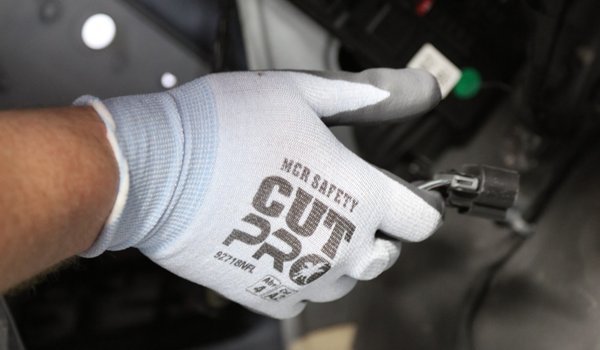
Workers handle a lot of nuts and bolts when assembling vehicles. Automotive workers require excellent hand dexterity, cut protection, and a PU dip for gripping automotive parts. Be sure to check out our Cut Protection page for additional information.
Learn More About Cut and Sense of Touch ProtectionCommon Applications:
- Adjusting small parts and screws
- Feeling fine parts
- Attaching cables
- Pulling wires
- Assembling doors and placing seats
General Purpose Protection
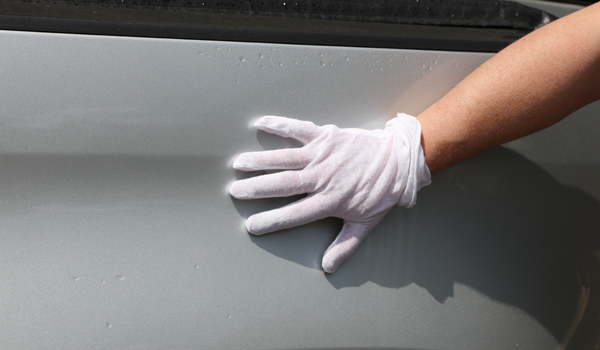
Sometimes workers only need limited protection, mostly to protect finished products. String-knit and disposable gloves are a perfect solution.
Common Applications
- Ideal for general everyday activities requiring limited protection.
Heat Burns and Hot Objects
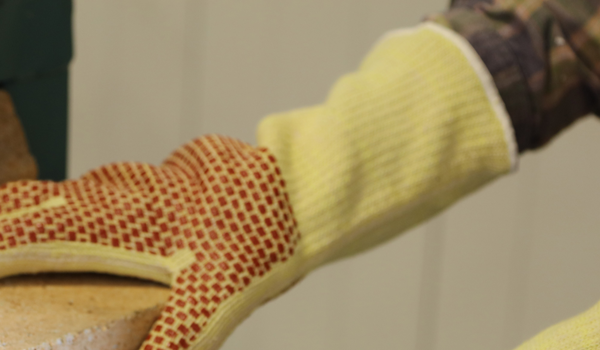
In die-casting, plastic molding and forging operations, workers can avoid injury by wearing some heavy gauge heat resistant gloves and gloves made with DuPont™ Kevlar®. Check out our blog on ANSI Contact Heat scores for additional information.
Learn More About Heat Burns and Hot Objects ProtectionCommon Applications:
- Maintaining machinery
- Handling molded parts
Heavy Metal Stamping
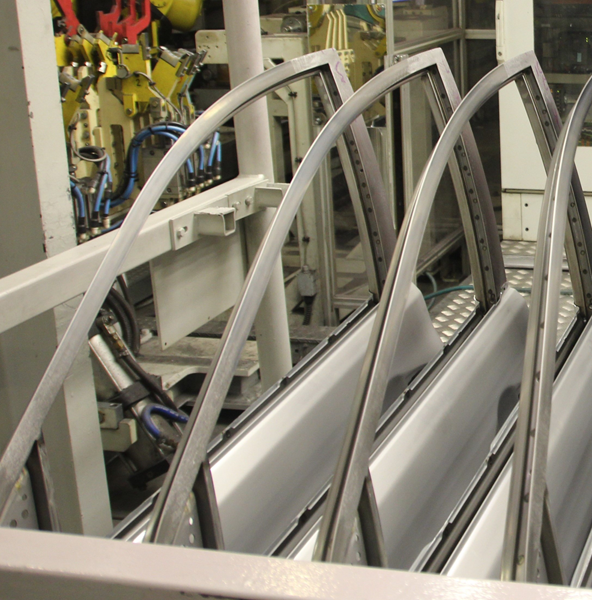
Once the machine press has blanked and formed the metal sheets, someone has to start manually handling that metal. Just make sure higher-rated ANSI cut-resistant gloves are worn. Be sure to check out our Cut Protection page for additional information.
Learn More About Heavy Metal Stamping ProtectionCommon Applications:
- Cutting and separating metal
- Handling metal panels
- Operating machine-press
- Destacking metal stamped parts
- Forming metal to desired shapes
- Connecting stamped panels
Impaired Vision
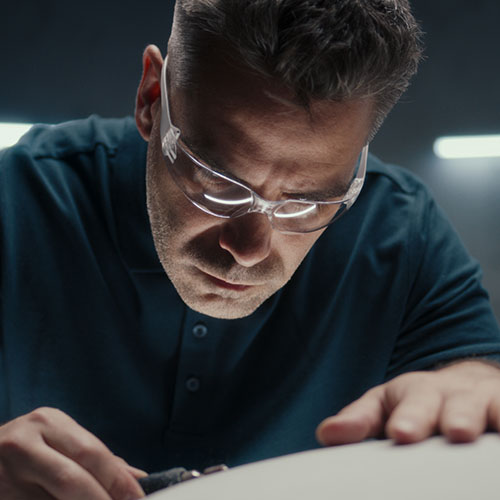
Assembling, grinding, painting, finishing, and welding processes occur in virtually every auto plant. Do you know what else occurs? Eye injuries. Thankfully, we make hundreds of safety glasses styles, ensuring workers have the optimal fit.
Learn More About Impaired Vision ProtectionCommon Applications:
- Cutting, shaping, and forming metal
- Repairing equipment and machinery
- Painting vehicle body
- Working in the pit area
- Filling fluids like anti-freeze
Inspection

Vehicle bodies and components have sharp edges. Running your hand over recently stamped metal allows you to identify unnecessary burrs and defects. Thin cut- resistant gloves will allow for touching and feeling across metal surfaces safely. Be sure to check out our Cut Protection page for additional information.
Learn More About Inspection ProtectionCommon Applications:
- Finishing
- Inspecting for unnecessary burrs
- Inspecting stamped parts
Lint Free PPE for Painting

Paint line workers must wear lint-free gloves when inspecting. Damaging vehicles with craters, fingerprints, and sweat on painted surfaces is not a good idea. Some nice disposable gloves will come in handy.
Common Applications:
- Painting vehicle body
- Checking body surfaces
- Applying sealers
- Cleaning tools
Manual Parts Handling
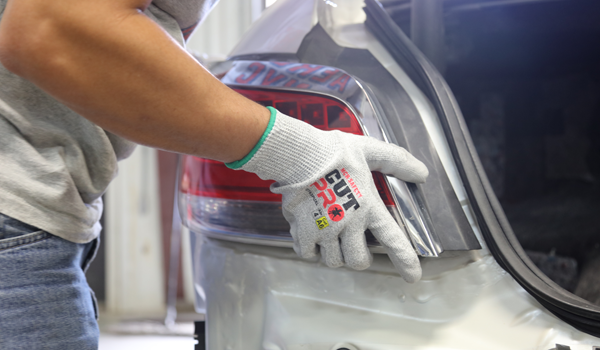
Automotive manufacturing workers handle molded parts and transport many of them to workstations where they will be assembled. Be sure to check out our Cut Protection page for additional information.
Learn More About Manual Parts Handling ProtectionCommon Applications:
- Handling rough, jagged, and ultra-fine sharp parts
- Metal handling
Oily Engine Components and Machine Parts
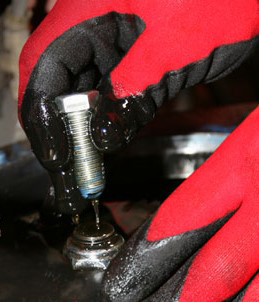
Engine assembly workers, along with maintenance and repair crews, come in contact with some oily substances. We've got coatings designed for this scenario.
Common Applications:
- Changing Parts
- Lubricating machines
- Assembling oily objects and components
Overall Visibility

Parts are always being sent to the assembly line and workers are always on the move from one work station to another. Make sure they're seen with proper PPE.
Common Applications:
- Delivering finished vehicles
- Delivering parts to work stations
- Receiving materials
- Forklift drivers transferring materials
Plastic Molding
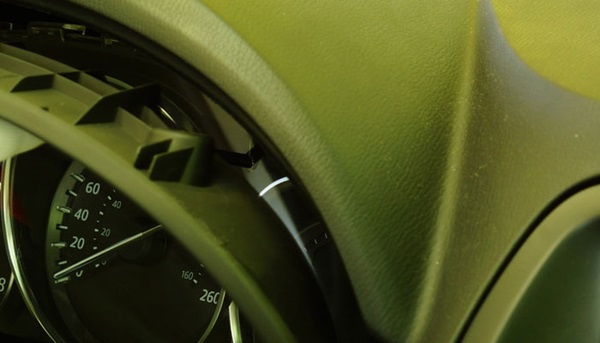
Injection molding facilities produce bumpers and interior trims. Contact with hot plastic spatter is a serious matter during this operation. Workers require PPE, ranging from heat-resistant gloves to face shields. Be sure to check out OSHA's etool on Injection Molding.
Learn More About Plastic Molding ProtectionCommon Applications:
- Handling molded parts
- Adjusting equipment
- Inspecting parts
- Mold Trimming
Precision Handling
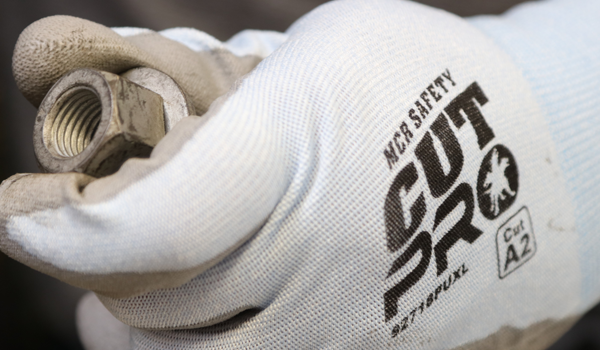
Handling small objects is a routine task for assembly workers. When you have a takt time in place, you need all the help you can get. Feather-light PPE is this worker's best friend.
Common Applications:
- Nuts and bolts handling
- Fine parts handling
- Fastening components
- Adjusting parts
Puncture
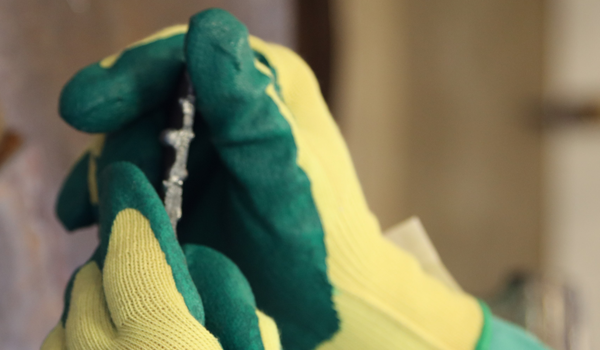
Some added puncture protection makes sense when deburring metal and grinding out burrs. Check out our Puncture Resistant blog for additional information.
Learn More About Puncture ProtectionCommon Applications:
- Deburring
- Metalworking and manipulating metal parts
- Bending and forming metal sheets to desired shapes
Repetitive Movement and Sense of Touch
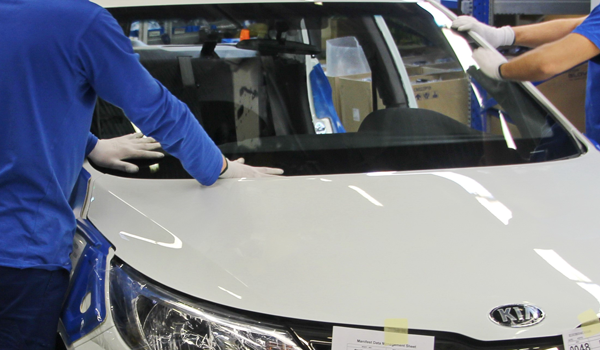
Electrical wire harnessing is an area that requires fit and feel. Our Ninja Light styles are 30% lighter than traditional PU styles.
Common Applications:
- Connecting devices
- Attaching cables
- Fastening components and parts
Robot Installation
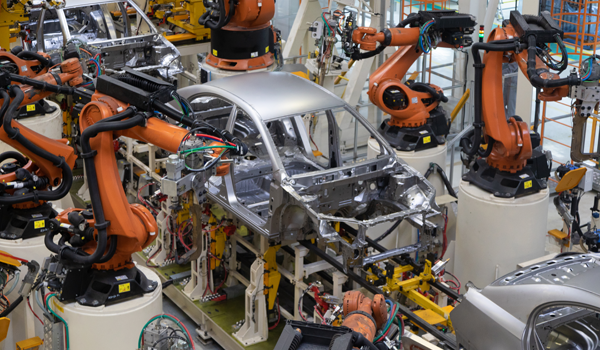
High-dollar equipment deserves high-quality PPE when workers assemble the thousands of robots found at production facilities.
Common Applications:
- Assembling and disassembling equipment
Sharp Objects, Cuts, and Lacerations
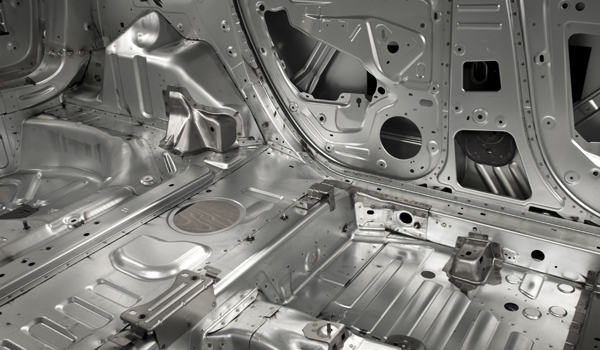
Metal, metal, and more metal is the best way of summing up car production plants. Lacerations make up 22% of motor vehicle manufacturing injuries. Carrying and connecting stamped metal panels to welding robots requires gloves with excellent cut resistance. Be sure to check out our Cut Protection page for additional information.
Learn More About Sharp Objects, Cuts, and Lacerations ProtectionCommon Applications:
- Handling sharp metal parts formed from the presses
- Assembling components like dashboards, panels, and seats
- Using a wide range of tools
- Handling hollowed metal parts
Touchscreen
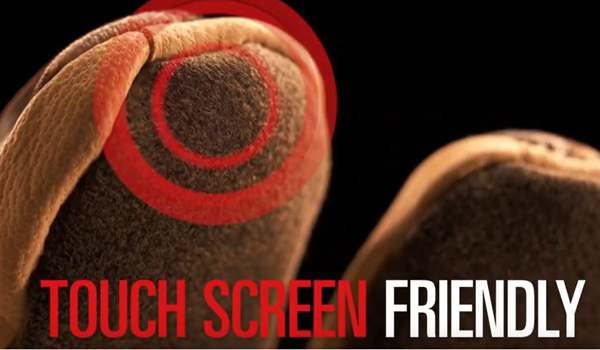
Maintenance and equipment service workers touch a lot of control panels. There is no reason to sacrifice wearing cut protection when our Orange Kevlar® styles offer this functionality. Check out our blog on Touchscreen gloves for additional information.
Learn More About Touchscreen ProtectionUncoated Feel
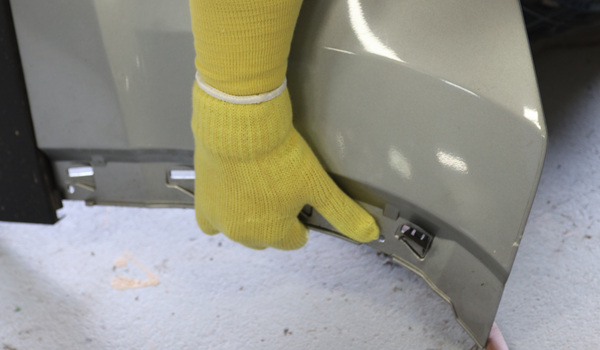
Workers sometimes need to run their hands over the vehicle to feel for imperfections. Uncoated gloves are what this worker should consider wearing.
Common Applications:
- Inspection
UV Radiation
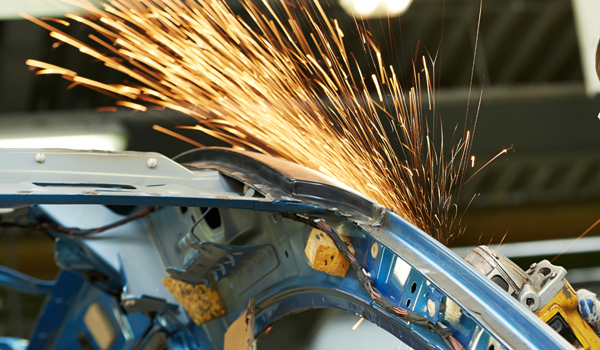
When cutting metal, be sure to wear properly filtered protective eyewear. We have an entire resource page dedicated to this needed protection. Be sure to check out our Welding Protection page for more information.
Learn More About UV Radiation ProtectionWelding and Cutting
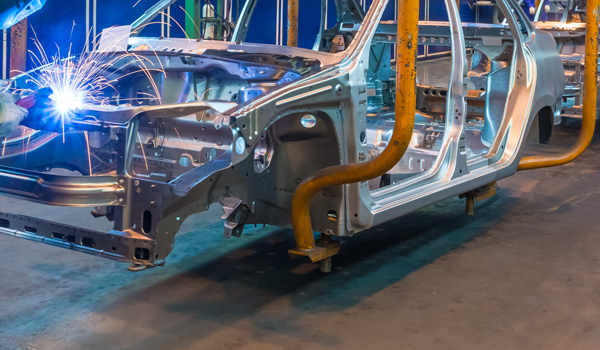
The robot can't reach every area of the automotive frame. Mig welders finish up the job wearing MCR Safety welding gear. Be sure to check out our Welding Protection page for more information.
Learn More About Welding and Cutting ProtectionCommon Applications:
- Welding metal pieces together
 Why MCR Safety Products?
Why MCR Safety Products? 
MCR Safety manufactures and supplies Personal Protective Equipment (PPE). Simply put, WE PROTECT PEOPLE! We are known world-wide for our extensive product line depth surrounding gloves, glasses, and garments spanning across numerous industries. We offer the total package of safety gear encompassing industrial gloves, safety glasses, protective garments, welding gear, industrial boots, Flame Resistant (FR) gear, face shields, and much more. From a glove standpoint alone, MCR Safety manufacturers and supplies over 1,000 different style gloves. Here are some of the many reasons MCR Safety is your go to source for PPE:
- Global PPE manufacturer, with operations stretching across 5 continents.
- Direct manufacturer of over 50% of all product, ensuring the highest level of quality.
- In conjunction with quality control measures resulting from direct manufacturing, our ITC Innovations Technology Center ensures another layer of testing glove quality. The ITC Lab is the only ISO 17025 accredited lab to perform ANSI/ISEA 105-2016 cut resistance, abrasion resistance, puncture resistance, and conductive heat resistance testing in North America. We offer no cost testing for users interested in knowing the quality level of current PPE being worn or for potential new products being considered.
- Winner of multiple new product innovation awards, most recently being the DM3 eyewear
- Dedicated 360° Safety Specialists ready for onsite PPE consultations.
Click here and see for yourself and learn more why our customers love our gloves!
Research Disclaimer
MCR Safety is recognized as a global manufacturer stretching across six countries, with both distribution and manufacturing facilities. Our core competency and specialty is manufacturing and supplying protective gloves, glasses, and garments. The information shown and provided on MCR Safety’s website, its safety articles, industry resource pages, highlighted hazards and safety equipment should be used only as a general reference tool and guide. The end user is solely responsible for determining the suitability of any product selection for a particular application. MCR Safety makes no guarantee or warranty (expressed or implied) of our products’ performance or protection for particular applications.
Automotive Industry Safety Insights and Information
Tradeshows
- American Automotive Summit
- Automotive Aftermarkets Products Expo
- Chicago Auto Show
- Florida RV Supershow
- Frankfurt Motor Show
- Geneva Motor Show
- Indianapolis Auto Show
- LMC Automotive
- Mid-America Trucking Show
- Mobile Tech Expo
- NACE Automechanika
- New York International Auto Show
- North American International Auto Show
- Paris Motor Show
- SAE Naples
- SEMA
- Seol Motor Show
- Society of Automotive Engineers
- The Great American Trucking Show
Associations
- Alliance of Automobile Manufacturers
- American International Automobile Dealers
- Automotive Aftermarket Suppliers Association
- Automotive Body Parts Association
- Automotive Parts Remanufacturers Association
- Automotive Service Association
- Certified Automotive Parts Association
- Electric Auto Association
- Electric Drive Transportation Association
- Engine Manufacturers Association
- Heavy Duty Manufacturers Association (HDMA)
- International Automotive Technicians’ Network
- International Brotherhood of Teamsters
- Japanese Automotive Manufacturers Association
- Mechanical Contractors of America
- Motor & Equipment Manufacturers Association
- National Auto Body Council
- National Automobile Dealers Association (NADA)
- National Automotive Service Task Force
- Rubber Manufacturers Association
- Society of Automotive Engineers (SAE)
- Specialty Equipment Market Association
- Truck and Engine Manufacturers Association
- U.S. Tire Manufacturer Associaiton
- United Auto Workers
Journals & Magazines
- AutoInc
- Automotive Design
- Automotive Digest
- Automotive Engineering
- Automotive Industries
- Automotive News
- Automotive Week
- Automotive World
- Body Shop Business
- Car & Driver
- Collision Repair Insight
- Collision Services Autobody
- Dealer Communications
- Edmunds.com
- International Journal of Automotive Technology
- Motor Age
- Motor Magazine
- Motor Trend
- Rubber & Plastics News
- Rubber World
- Select USA
- Truck News
- Trucking Info.
- Wards Auto
